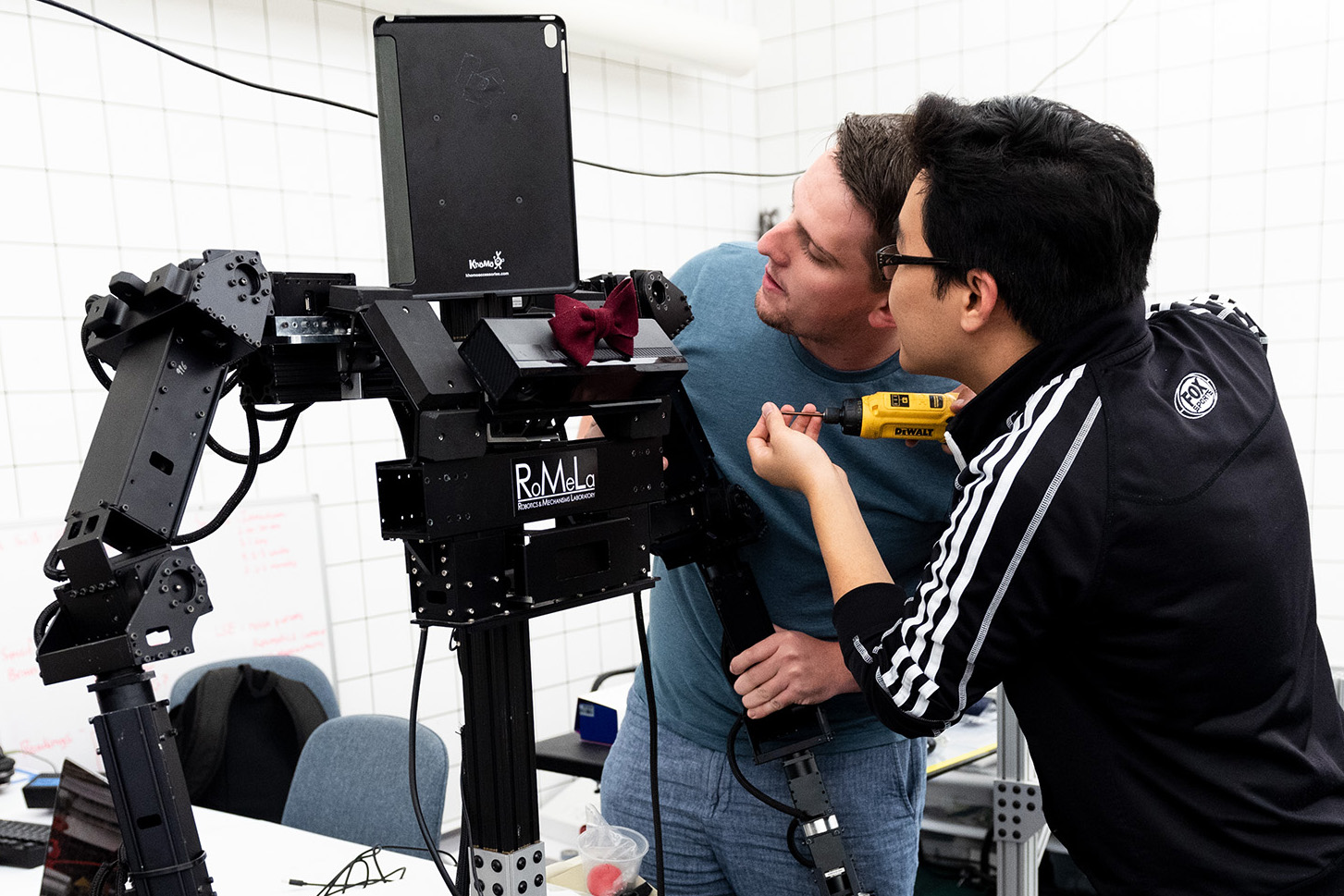Robot learns magic tricks for Netflix show, but won’t endanger human jobs

(Liz Ketcham/Assistant Photo editor) Graduate students in RoMeLa temporarily fix MAGI’s arm.
By Teddy Rosenbluth
Sept. 27, 2018 1:57 a.m.
MAGI grasped a silver cup between its two metal claws in one hand. With the other hand, the robot dropped a red, bubble gum-sized ball into the cup.
A graduate student sat in the background, his hand hovering over an emergency stop button.
After a couple of rigid waves over the cup for dramatic effect, MAGI turned the cup upside down to reveal red confetti, the ball nowhere in sight.
MAGI used to be the top half of an emergency responder robot that could open doors and turn levers in hazardous situations. Now, it sits in the corner of UCLA’s Robotics and Mechanisms Laboratory, wearing a red bow tie and performing beginner-level magic tricks.
MAGI, which stands for Magic, Arts and Gaming Initiative, is one of many robots, including the marimba-playing robot and dancing robot, attempting to enter the entertainment industry.
“There are jobs we generally thought were safe for humans, like creative jobs,” said Dennis Hong, the principle investigator of RoMeLa and an amateur magician. “Because of advancements in artificial intelligence, robots are going to start to take over jobs in those fields.”

But this robot still needs to master the mechanics of basic tricks before it threatens any magician jobs, said Matthew Williams, a graduate student in the lab.
“Robots are dumb while human motion is smart and there are a lot of complications that go into trying to create a human motion,” Williams said.
Researchers in the lab built MAGI in one week to perform in one episode of a Netflix show called “Magic for Humans,” which funded the project. During that week, graduate students spent more than 40 hours practicing the tricks and fixing pieces when they broke.
Sometimes an elbow motor would fail carrying heavy props. Sometimes an arm would shoot out unprompted, nearly hitting the graduate students. Once, the robot exhausted its engine grasping at nothing.
“We’re dealing with a robot that wants to potentially break itself to get what we want it to do,” Williams said.
The robot executed its tricks well for the Netflix taping but lost an arm after only a few performances.

Justin Quan, another graduate student in the lab, said he thinks the robot could perform more complex tricks if researchers had more time and newer equipment. He said it might even be able to create its own tricks using artificial intelligence.
Steve Spill, a performer and founder of the magic theater Magicopolis in Santa Monica, said he does not feel like his career is threatened by robots like MAGI, even if they are able to create their own magic tricks.
“If you gave ‘Mary Had a Little Lamb’ to Bob Dylan or Taylor Swift, they would all sing the song and it would have a part of them in it. That’s what art is,” he said. “It has nothing to do with the trick, it has nothing to do with the song, it’s about the performer.”
Hong said he thinks robots could eventually exceed magicians’ abilities in technically challenging tricks by adding features such as extra fingers and hidden pockets.
However, he said part of the appeal of magic is understanding basic human limitations and then watching the magician violate them in a trick.
“You assume ‘that’s a robot, it could have built things into it’,” Hong said. “That’s no fun because you start with the assumption that (the robot) has abilities better than the audience.”
Spill agreed, comparing it to magic on television.
“You can’t help but think maybe there’s trick photography or something happening out of the frame of the screen,” he said. “The same could be said about robots.”
Hong also said successful magicians have many intangible qualities robots will never be able to recreate.
“This gets into the realm of what artificial intelligence can and cannot do,” Hong said. “We have the technology to build robots that look and feel like they have emotions, but I do not believe we’ll be able to build a robot with true emotion.”


